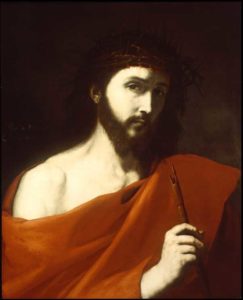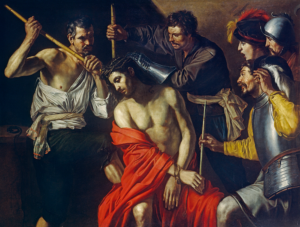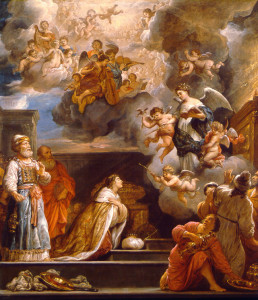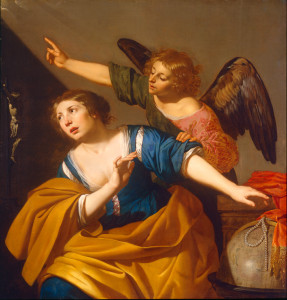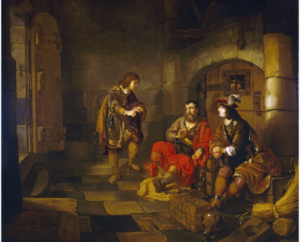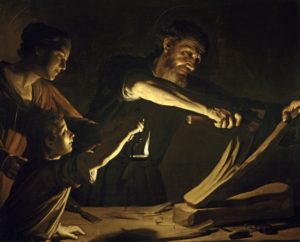St. Cecilia
Oil on canvas
Giovanni Lanfranco
Roman, 1582-1647
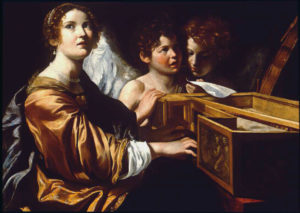
Generally, a painter’s style refers to the way an artist executes a painting. Style can also be described as a general trend in painting usually initiated by an artist seeking to paint in an innovative or previously unexplored way. However, a specific artist’s style can often be revealed in his individual expression—idiosyncrasies that help experts identify his work. For example, an artist may paint faces with certain characteristics (i.e. chubby cheeks, almond-shaped eyes, or small ears), use backgrounds in a similar way, or mark out his composition with heavy drawings before painting.
The technique an artist uses to apply paint is also characteristic of style. Every painter employs certain techniques that become distinctive to them—Botticelli outlined his figures; Rembrandt used very thick paint in highlights; Degas used hatching marks in his pastels; Van Gogh used thick paint for each individual brushstroke, etc… So, the actual stroke and method an artist uses to apply paint becomes an integral part of his personal style. Connoisseurs and scholars thoroughly inspect, discern, and memorize both the artist’s characteristic techniques and the general style or trend the artist follows—these are subjective considerations in determining a painting’s attribution.
To illustrate the concepts of style and technique, consider the context of Lanfranco’s painting of St. Cecilia from c.1620. At the turn of the 17th century, Italian artist Caravaggio initiated a style of painting viewed as revolutionary for his time. Artists all around him were painting in the “mannerist” style of the time—an eclectic blend of ideal forms with asymmetrical compositions, uneven or overall lighting effects, and garish colors. However, Caravaggio broke from these conventions to explore the dramatic possibilities of lighting combined with a candid, straightforward realism.
Caravaggio’s innovative style flourished rapidly within Rome’s fertile artistic environment, and Giovanni Lanfranco was one of the artists influenced by Caravaggio’s radical style, as evidenced in M&G’s painting. The half-length figures emerge from a dark background, bathed in a heavenly light streaming in from the upper left. The effect is intensified by deep shadows covering nearly half of each figure. This manipulation of light mixed with a strong sense of realism meet the criteria for the style that Caravaggio inspired called tenebrism.
Lanfranco worked in the tenebrist style intermittently throughout his career, with this St. Cecilia being one of his best representative works. However, M&G’s work is not his only treatment of this subject. The National Gallery’s St. Cecilia and an Angel in Washington D.C. provides unique insight into identifying Lanfranco’s particular style and technique; the National Gallery painting has been confirmed as a collaboration of two artists—Giovanni Lanfranco and Orazio Gentileschi. In 1990, Erich Schleier, the foremost scholar on Giovanni Lanfranco, expressed the opinion that the sleeves and hands of St. Cecilia reflect the style of Lanfranco (for centuries before, the painting bore a firm attribution to Orazio Gentileschi, one of Caravaggio’s principal Roman followers). Following Schleier’s input, further research was made into the old Rondanini inventories from which the National Gallery (and M&G’s) painting once belonged. Alessandro Rondanini’s painting inventory compiled on January 19, 1741 described two St. Cecilia paintings: one (M&G’s) by Lanfranco says, “St. Cecilia playing the cembalo with two angels,” and the other St. Cecilia (National Gallery) “with the heads by the hand of Gentileschi and the rest by Giovanni Lanfranco.”
Not only did the 1741 inventory confirm the attribution of the National Gallery’s painting to Gentileschi and Lanfranco, but analysis of x-radiographs, pigments, and x-ray fluorescence by National Gallery conservators have also supported this conclusion. This remarkable example reveals how expert (subjective) opinion by Erich Schleier led to objective proof for the collaborative attribution found in an old inventory and supported by scientific tests.
Studying the sleeves of M&G’s St. Cecilia furnishes insight into Schleier’s stylistic and technical analysis of comparing Lanfranco’s hands and sleeves in the Washington painting. Cecilia’s hands in both works are formed in a curved manner, almost as if no bone structure supported the flesh. Since artists tend to paint similar figural forms in paintings from a particular phase of their career, the stylistic detail of the hands in the Washington and Greenville paintings reflect the way Lanfranco uniquely handled this element of his composition. The flowing sleeves have highlights painted with rapid, bold brushstrokes, which is another stylistic trait carried over in each work.
In 1620, Lanfranco turned from the influence of other artists and was the first to develop an inventive style of ceiling fresco that presents an atmospheric illusion of figures rising into the heavens by using dramatic foreshortening and figure recession as seen in the fresco of the dome of S. Andrea della Valle in Rome; this Lanfranco innovation created a sensation inspiring many artists after him to use and develop this style.
John M. Nolan, Curator
Published in 2014
